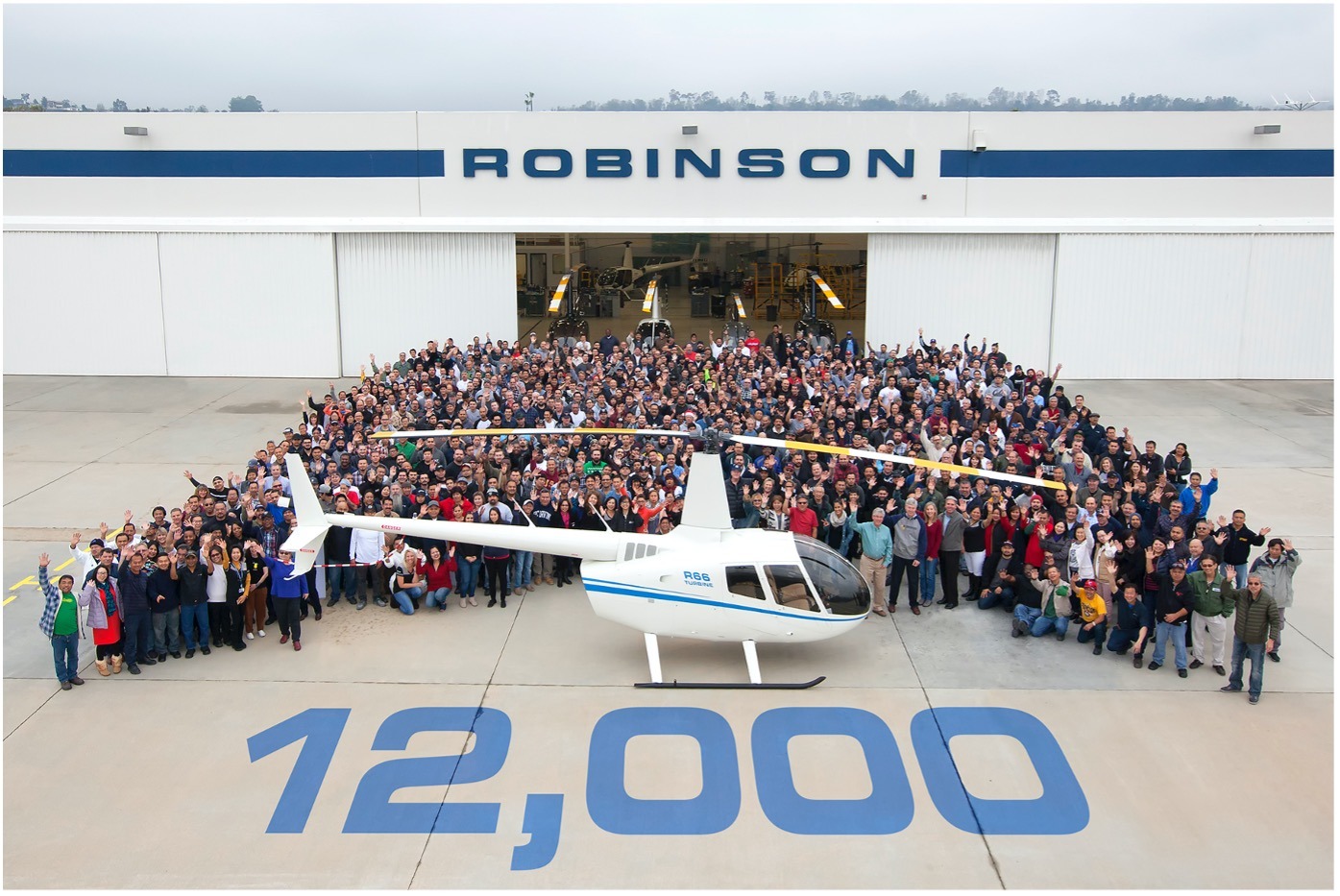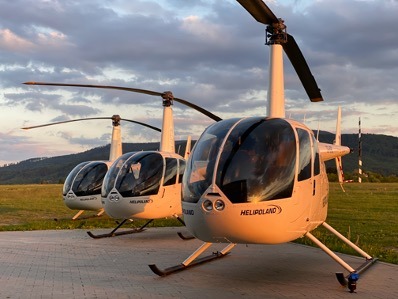Robinson Helicopters – Company history
Robinson Helicopter Company – Torrance, California is the world’s leading manufacturer of civil helicopters. Robinson is one of the first aviation companies in North America to achieve ISO 9001 certification for helicopter design, production and service. To maintain the highest quality standards, the company carries out most of the operations including welding, machining, assembly, painting and on-site flight testing at its Torrance airport facility.
Key Dates:
1973: Frank Robinson begins designing his first prototype helicopter.
1975: The R22 helicopter makes the first test flights.
1979: R22 is certified by the Federal Aviation Administration (FAA) and deliveries begin.
1987: Robinson makes his first profit.
1988: The company produces more helicopters per year than any other manufacturer.
1989: With 310 units delivered, the R22 is the world’s best-selling light aircraft of the year.
1991: R22 production peaks at 402 units.
1997: R44 variants were introduced for police and television crews.
2001: Robinson promotes light heliports for businesses.
The company’s history:
Robinson Helicopter is a leading manufacturer of light piston engine helicopters. It produces more civilian helicopters per year than any other manufacturer, and 80 percent of those manufactured in the United States. The two-seater Robinson helicopters R22 and four-seater R44 helicopters offer public and private users a low-cost alternative to turbine helicopters such as the Bell JetRanger. Robinson builds most of his own components.
Beginnings:
Frank Robinson was born in 1930 and grew up near Seattle. He funded his education at the University of Washington by working on cargo ships, reports Forbes; thus he only graduated from the age of 27. Robinson began his engineering career working on the CH-1 Skyhook for the Cessna Aircraft Company. He later worked on rotorcraft research for manufacturers such as McCulloch Motor Company, Kaman Aircraft, Bell Helicopter and finally Hughes Aircraft Company, which he joined in 1969.
Robinson spent 16 years trying to convince his airline employers that such a market even existed. Robinson was not the first person to strive to create an inexpensive helicopter for personal use. Designer Stanley Hiller fueled the idea in the late 1940s, and some futurists from the 1950s and 1960s had a helicopter in every driveway. However, it was the military that used helicopters the most, starting from the Korean War.
Against the advice of his colleagues, Robinson made his own decision in June 1973. Design work on his new light helicopter consumed the lounge and garage at Robinson’s Palos Verdes mansion, which was pledged to finance the helicopter’s development. Robinson was also looking for key employees close to home. His wife Barbara became director of marketing, and three of the couple’s six children also ended up working for the company. Some called them “Swift Family Robinson.”
In 1975, Robinson had a working prototype of the first model, the R22, which was constructed in a tin hangar at Torrance Airport in Southern California. It took four years to obtain FAA certification. The prototype was then sold to the flight school, which he didn’t even consider when he started developing the helicopter. The R22 will eventually dominate the global training helicopter market. Another important early market was radio stations that used helicopters to report traffic conditions.
Robinson Helicopter soon opened a factory at Torrance Airport. Initial funding ranged from $ 2 million to $ 3 million. Frank Robinson told the American Metal Market that $ 500,000 of that amount went to computer-controlled machine tools.
The lightweight reciprocating helicopter could compete with its turbine rivals for a fraction of the cost. Powered by a 160 hp Lycoming engine, the R22 had a fiberglass hull and sold for a base price of $ 40,000. The R22, which was said to be the quietest helicopter in the world, was found to consume 50 l / h of flight. The R22 finally broke the world records for speed and altitude in its class.

Robinson anticipated selling 500 units a year by 1982, American Metal Markets reports, but did not reach that number due to the recession. After producing eight planes in 1979, Robinson produced 78 in 1980 and 176 the following year. The company had 150 employees at the time.
The crisis and the recovery in the 1980s
Robinson continued to improve his products. In September 1981, it began offering the more powerful R22 HP for a base price of $ 59,850. The R22 Alpha with increased total weight was launched two years later. In August 1985, the company introduced the Beta R22, equipped with advanced avionics. A version equipped with floats, dubbed the Mariner, was introduced later this year and was priced at $ 94,850.
In addition to the recession, product liability was another major factor in the slowdown in sales across the US aerospace industry in the early 1980s. Robinson, Forbes reported, did not have liability insurance due to the tremendous confidence in his product. However, two early R22s suffered fatal accidents, leading to a redesign of the rotor blades. Sales dropped to just 64 units in 1983. Robinson has generally been successful in winning, dismissing or settling lawsuits for reasonable amounts.
The production, driven by overseas sales, quickly returned to normal. By the mid-1980s, Robinson was exporting half of its production. Rotorcraft were quite popular with livestock farmers. After several years of breaking into zero, the Robinson Helicopter made its first profit in 1987.
Revenue reached $ 23.5 million in 1988 when the company sold 204 units. The fully equipped R22 then sold for around $ 105,000. The weak dollar was good for exports, which accounted for 80 percent. sales. During this time, Robinson sold more helicopters than anyone else, including Bell, Sikorsky, Boeing, and McDonnell Douglas. At that time, Robinson employed 310 employees.
Two more armchairs in the 1990s
While California’s giant military aviation companies were not working after the collapse of the Soviet Union, the Robinson Helicopter flourished. The company delivered 384 R22 in 1990; sales totaled $ 48 million. The company had sales of $ 50 million in 1991 when it shipped a record 402 helicopters. Employment will soon exceed 400 employees.
Frank Robinson began working on the four-seat helicopter design in the mid 1980s. The first prototype took off in March 1990. Its larger size also opened up new possibilities for police work, agriculture and fish watching. Robinson began taking orders for the R44 in March 1992 for $ 235,000 for a fully equipped model. The Bell Jet Ranger, a five-seat turbine-powered helicopter, cost $ 600,000. The R44 was also characterized by low operating costs and required less servicing than typical helicopters. In fact, its maintenance schedule was similar to that of light aircraft – only maintenance was carried out every 2,000 hours (later extended to 2,200 hours).
The first production of the R44 Astro was delivered in February 1993. Robinson planned to launch a production line for this aircraft in Santa Maria until the City of Torrance offered the company a good rate on the lease of additional land. The allegedly arduous licensing process for Santa Maria helped seal this decision. Robinson also looked at locations in the South and Midwest. Robinson moved to a new 260,000 square foot factory in July 1994.
However, sixty employees were soon laid off due to slowing sales. The National Transportation Safety Board (NTSB) soon began investigating the R22 after a wave of accidents. They were eventually attributed to the pilot’s error.
In 1996, the R22 Beta II was introduced, which had a new engine and offered improved hover performance for a base price of $ 135,000. Robinson released a special variant of the R44 intended for the police in mid-1997. Its front tower could be equipped with infrared sensors or a video camera. Around the same time, the R44 Newscopter, adapted for television broadcasting, made its debut.
In the late 1990s, the company continued to grow. During this time, the R44 – the more versatile with four seats – became the best-selling helicopter in the world. (The R44, which featured new hydraulic controls after 1999, was valued at around $ 300,000 at the time.) An overcrowded backlog required a major expansion of the Torrance factory. Robinson had 800 employees in 2000.
New horizons after 2000
Production fell from 390 units in 2000 to 328 in 2001; Robinson continued to outperform the Eurocopter, its closest quantitative rival, whose production rose fifteen percent to 280. The US helicopter industry saw a general decline due to the strong dollar, recession and the terrorist attacks of September 11, 2001.
Frank Robinson made large donations to two projects related to the history of aviation. In 2000, he donated $ 1 million to the Smithsonian National Air and Space Museum to finance a rotorcraft exhibition at the new Dulles airport facility. Two years later, the American Helicopter Museum received another million dollars to purchase a building in West Chester, Pennsylvania.
Like other manufacturers, Robinson kept an eye on the emerging Chinese market where by 2010 it was expected to bring 2,000 helicopters to the market. Russia was another important new territory. In the United States, Robinson was behind the initiative to put light heliports on business buildings and industrial parks. In early 2002, a Honda dealer in Santa Ana, California began assembling the first one in his car park. He was planning to commute to work in his R44.
Source: fundinguniverse.com / translation helipoland.com
Foto: Archive of Helipoland / Robinson Helicopters




